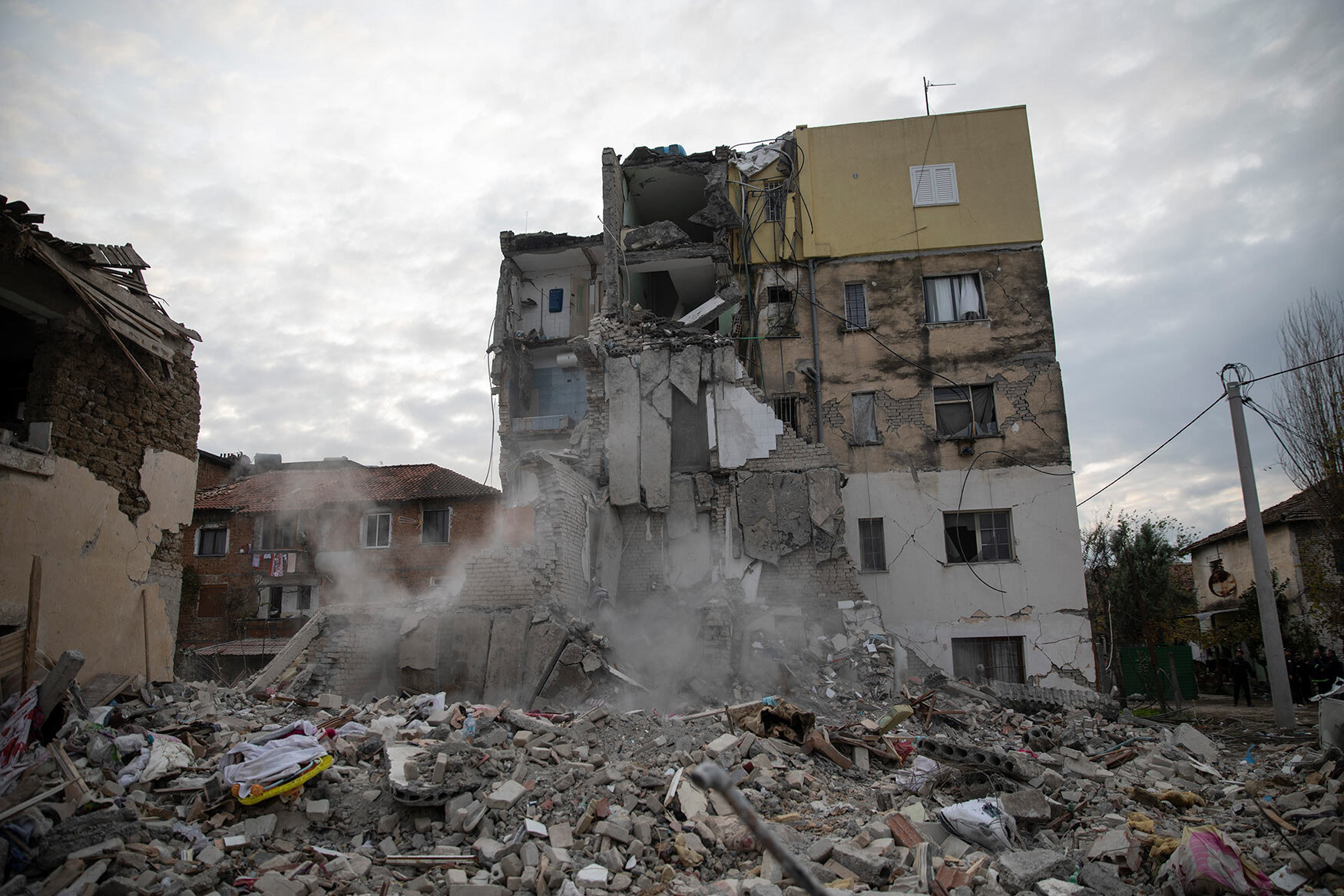Moria, the migrant crisis that shook the EU

Moria refugee camp was never far from crisis.
Created in 2013, before a massive influx of migrants five years ago, Greece’s largest refugee facility quickly exceeded capacity, spilling into surrounding olive groves on the island of Lesbos.
With its squalid living conditions, frequent protests, and tension with local communities who saw their livelihoods disputed, Moria became a symbol of the impasse facing the European Union, unable to address the volatile migration issue with a policy accepted by all of its member states.
The camp’s life ended as it began, in drama: Successive fires that started before dawn on Sept. 9 devastating the site and making 12,000 inhabitants homeless during a COVD-19 lockdown.
Refugees and migrants walk at the destroyed by a fire Moria camp, in Lesbos island, Greece, Sept. 9, 2020. (AP Photo/Petros Giannakouris)
Lesbos was again faced with a humanitarian crisis on a scale not seen since 2015, as families slept outdoors, most on the side of a highway near the gutted camp.
Protests quickly broke out as many migrants sought to travel to Greek mainland and onto Europe, while authorities feared they might lose control of the spread of the pandemic.
The crisis was eventually contained with a heavy deployment of police, a swift payout of European Union emergency aid, and the use of the army to build a tent city with a capacity of 10,000.
The government says what remains at Moria will be demolished, while its former inhabitants prepare to spend the winter in tents.
And the European Union says the crisis has added urgency to its efforts to forge a common migration policy.
Here’s a look in images of the ten days that rattled Greece and the continent.
A pregnant woman looks on as she stands among debris at the damaged by fire refugee and migrant camp of Moria, in Lesbos island, Greece, Sept. 9, 2020. (AP Photo/Petros Giannakouris)
Refugees and migrants carrying their belongings flee a fire burning at the Moria camp in Lesbos island, Greece, Sept. 9, 2020. (AP Photo/Petros Giannakouris)
Refugees and migrants carrying their belongings flee a fire burning at the Moria camp in Lesbos island, Greece, Sept. 9, 2020. (AP Photo/Petros Giannakouris)
An Afghan woman sits on a bed of her burned tent following a fire that completely destroyed the Moria refugee and migrant camp in Lesbos island, Greece, Sept. 10, 2020. (AP Photo/Petros Giannakouris)
Migrants sleep on the road near the destroyed by a fire Moria camp on the northeastern island of Lesbos, Greece, Sept. 10, 2020. (AP Photo/Petros Giannakouris)
Refugees and migrants protest near Mytilene town, on the northeastern island of Lesbos, Greece, Sept. 11, 2020. (AP Photo/Petros Giannakouris)
Afghan children play inside an abandoned car as refugees and migrants from the destroyed Moria camp are sheltered, near a new temporary camp, on the island of Lesbos, Greece, Sept. 16, 2020. (AP Photo/Petros Giannakouris)
An Afghan woman holds her baby as she runs to avoid a small fire in a field near where refugees and migrants are sheltered, in Lesbos island, Greece, Sept.12, 2020. (AP Photo/Petros Giannakouris)
Two children from Afghanistan inside a crate are pooled by a man in the road that refugees and migrants by the destroyed Moria camp are sheltered, on the island of Lesbos, Greece, Sept. 11, 2020. (AP Photo/Petros Giannakouris)
A Pakistani migrant washes him self, near the destroyed Moria refugee and migrant camp, on the island of Lesbos, Greece, Sept. 16, 2020. (AP Photo/Petros Giannakouris)
Refugees and migrants from the destroyed Moria camp are handed tomatoes during a food distribution, in the island of Lesbos Greece, Sept. 10, 2020. (AP Photo/Petros Giannakouris)
Children sleep on the road near the destroyed by a fire Moria refugee and migrant camp in the island of Lesbos, Greece, Sept. 10, 2020. (AP Photo/Petros Giannakouris)
An afghan woman wash her daughter with a plastic bottle as refugees and migrants from the destroyed Moria camp are sheltered in an nearby road on the island of Lesbos, Greece, Sept. 10, 2020. (AP Photo/Petros Giannakouris)
A woman collapses as refugees and migrants from the destroyed Moria camp take part in a prayer in Lesbos island, Greece, Sept. 13, 2020. (AP Photo/Petros Giannakouris)
An Afghan man from the destroyed Moria camp , looks at he mobile phone as he lies down in a tent, on the road that refugees and migrants are sheltered, in Lesbos island, Greece, Sept. 17, 2020. (AP Photo/Petros Giannakouris)
A boy from the destroyed Moria refugee and migrant camp jumps in to the sea on the island of Lesbos, Greece, Sept. 15, 2020. (AP Photo/Petros Giannakouris)
A two-month old baby from Afghanistan sleeps at a makeshift swing in an abandoned building where refugees and migrants from the destroyed Moria camp are sheltered, in island of Lesbos, Greece, Sept. 15, 2020. (AP Photo/Petros Giannakouris)
Refugees and migrants from the destroyed Moria camp pray on the road that are sheltered, in Lesbos island, Greece, Sept. 13, 2020. (AP Photo/Petros Giannakouris)
Refugees and migrants from the destroyed Moria camp cook over makeshift fires, on the island of Lesbos, Greece, Sept. 17, 2020. (AP Photo/Petros Giannakouris)
Refugees and migrants from the destroyed Moria camp cook over makeshift fires, on the island of Lesbos, Greece, Sept. 17, 2020. (AP Photo/Petros Giannakouris)
Refugees and migrants from the destroyed Moria camp sit on an abandoned gun emplacement in front of the new temporary camp, on the island of Lesbos, Greece, Sept. 16, 2020. (AP Photo/Petros Giannakouris)





